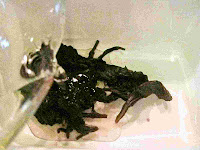<Ingredients>
20 g akajiso purple perilla leaves (33 smallish leaves in photo)
1 tsp salt (for mixing with akajiso)
For pickling brine
100 cc umezu (white or red)
OR
100 cc rice vinegar
1 tbsp+ salt (to mix in rice vinegar)
<Directions>
1.
(If using rice vinegar and salt mixture for brine)
Mix salt and rice vinegar well until salt is dissolved.
2.
Place akajiso in a bowl, and rinse well.
Squeeze out excess water, place in a bowl.
3.
Sprinkle salt, and rub until liquid comes out.
The liquid tastes harsh, so squeeze it out, and place leaves in a clean container.
4.
Pour brine, and keep refrigerated for 2+ days.
(4 days later in photo)
5.
Squeeze out brine, spread each leaf on a zaru strainer or basket, and dry outside in shade for about 2 days.
(1 and a half days later in photo)
6.
When dry and crispy, crush with hands into suribachi mortar.
Grind with pestle to desired fineness.
Leaf veins can be discarded or cut into small pieces with kitchen scissors.
Keep in airtight container.
<Notes>
- When using rice vinegar and salt as brine, recommended salt content is 10-20% by weight (umezu usually contains up to 20% sodium). One tbsp kosher salt is approximately 9 g. Because the weight of salt by volume differs by type and product, check your salt type and weight to prevent excessive saltiness.
- A much simpler method after Process 3 is to dry leaves in shade until crispy. However, marinating in vinegar (or umezu) is the key to obtaining a reddish color at the end (left dish in photo at left). Without this step, akajiso no furikake becomes grayish (right dish in photo).
- Aside from use as a rice topping, akajiso no furikake is often mixed in rice, or mixed with pale color crispy vegetables such as daikon radish and kabu turnip to turn them into instant pinkish pickles. It is also used as a seasoning in various dishes.
- Akajiso no furikake often goes by the synonym Yukari, the registered trademark of Mishima Foods, a major furikake company.























How do you use the left over brine ?
ReplyDeleteHi Jill,
ReplyDeleteMaking pickles and coloring ingredients. Can be used as a part of dressing as well. It has a nice shiso aroma.
Can I use a dehydrator?
ReplyDeleteNever personally tried, but I think you can.
Delete